
Prost laments Renault’s ‘sad’ F1 exit: ‘It’ll be difficult to come back’
Alain Prost has given his view on Renault exiting F1 as an engine manufacturer
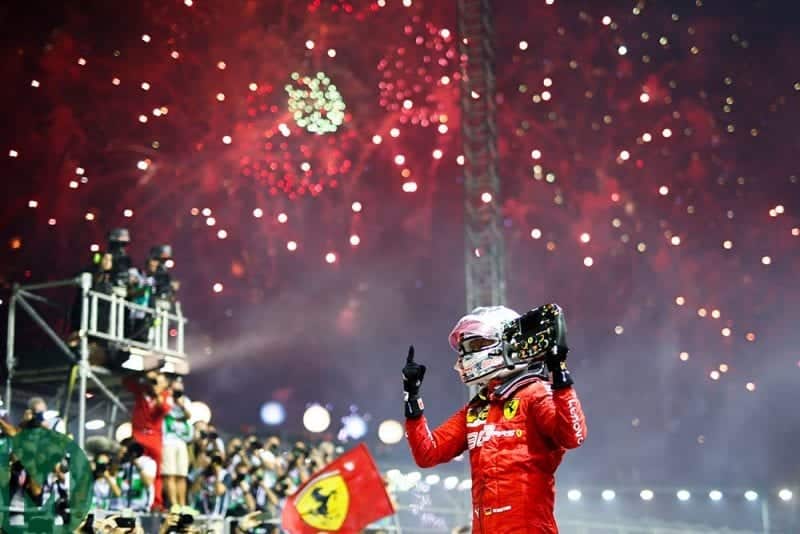
A well-timed pitstop gifted Sebastian Vettel the lead in the 2019 F1 Singapore Grand Prix, but his win came down to much more than luck
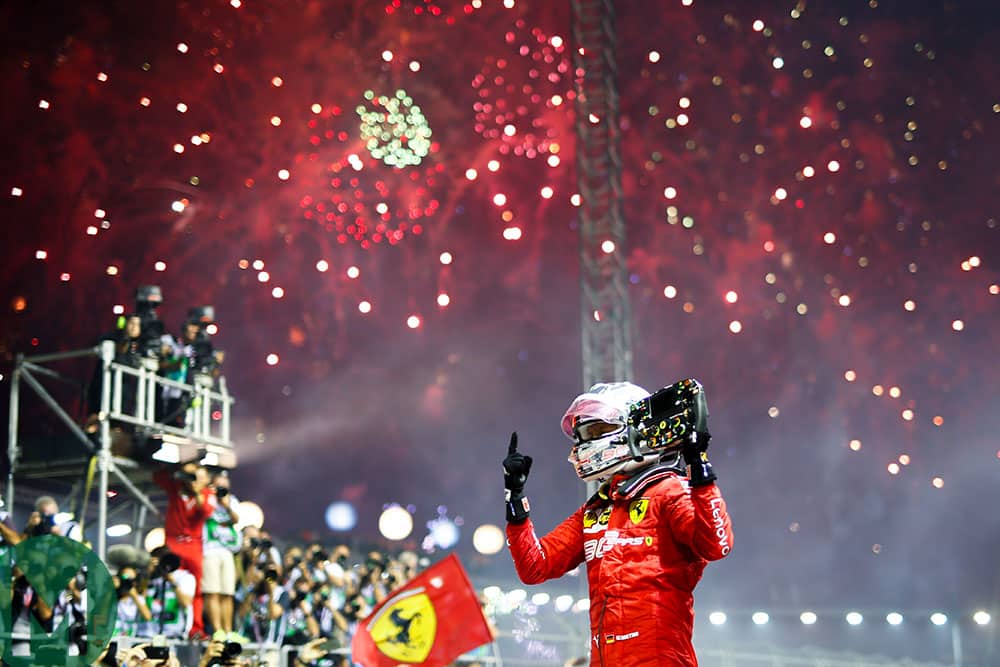
Photo: Motorsport Images
In the Ferrari that was never going to win at a track like Singapore, the driver that was never going to prevail over his team-mate led a 1-2. Sebastian Vettel was the recipient of a present of strategic second-guessing that fell for him and against Charles Leclerc. In the process, Ferrari converted a 1-3 to a 1-2. Which wasn’t really much of a consolation to Leclerc who’d stamped his authority on the weekend brilliantly.
It was a result that could hardly have come at a better time for Vettel as an answer to the questions created by his recent run of poor form. He took his chance and he ran with it with the practised ease of someone who knows very well how to win. But on raw performance, this was never anything than Leclerc’s weekend; how Ferrari had undercut his teammate ahead of him took quite some explaining.
But this wasn’t a normal race. Just like last year, it was a strange dance of circulation-pursuit where the back of the field was often lapping quicker than the front as Ferrari tried to compress the field so much that no-one could make an undercut attempt. The plan then was to let rip as the pit stop window opened. But when they did that, they found the tyres – the Pirelli C5s that were the softs here – just didn’t have any performance left in them. In trying to run long enough to be sure of getting to the end on a one-stop, they ran so long that there was no grip left when the time came to sprint clear prior to the stops.
Mercedes was perhaps over-confident in its likely advantage over Ferrari here
This made the undercut massively powerful. It turned out that fresh hards were 3.9sec faster than 20-lap old softs. But this was only discovered in hindsight. So when Ferrari pitted Vettel first – to a) head-off an undercut from Max Verstappen’s Red Bull and b) to apply undercut pressure to Lewis Hamilton’s second-placed Mercedes – it inadvertently leapfrogged Vettel past not only the Mercedes, but his own team-mate too.
They were just the circumstances of the odd consequences of Pirelli bringing its rarely used, very softest tyre to this track. It’s so much faster in qualifying that no-one could consider using the medium in Q2 but its range is so short that it made it far from certain you’d be able to do the faster one-stop strategy.
That’s partly because of the pitlane length, layout and low speed limit that makes a pit stop around eight seconds more costly than at most tracks. So the game: circulate slowly, up to five seconds off the pace, to lengthen that first stint and to ensure there are no gaps for a would-be undercutter to fall in to.
The challenges of that very Singapore-specific game of chance and jeopardy was what led Ferrari to make the strategic decision it did. But the specifics of how Ferrari had got itself in a position to be able to make that choice were nothing to do with chance. The Ferrari SF90 was flying around a track not expected to suit it, partly through a very effective aero upgrade that gave it the front end it usually lacks, partly because it loves that C5 tyre, partly because the adventurous, ambitious, vastly gifted Leclerc had convinced the team to prioritise qualifying above all else in the car’s set up. Fifteen laps under the safety car rescued them from the possible downside of that.
Mercedes had gone in the opposite set-up direction – way too far as it turned out – perhaps over-confident in its likely advantage over Ferrari here. At Red Bull, Verstappen had played a part in the choice of a lower than maximum downforce level and had optimised the car in the simulator based around that, but with wrong information about the severity of the bumps and kerbs here. Consequently, the RB15 spent the weekend bouncing from one bump to the next and porpoising out of the exits.
Vettel spoke of how grateful he was for the support he’s had from many fans as he’s suffered his doldrums. He wasn’t deliriously happy, just realistically so. “After Monza I was down for myself and happy for the team. Now I’m happy for myself but still very up for the team… you are misguided if you ever think you are bigger than this team.”
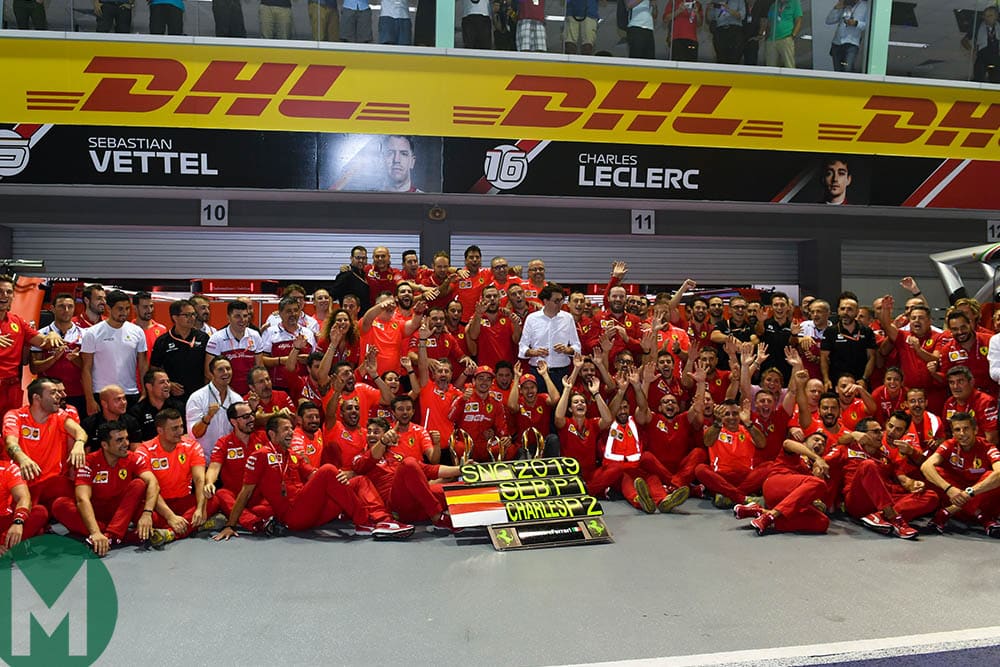
Ferrari is the first team to secure a 1-2 finish in Singapore Photo: Motorsport Images
So with one devastating Leclerc pole lap, Ferrari became proper 2019 contenders rather than a one-trick low-drag pony. Its horsepower advantage was still very evident in the long drags of sector one, where it consistently took a couple of tenths out of the Mercedes. That much was expected. What was not expected was that it would lose hardly any time in the remainder of the lap, the repeated slow corner twists and bumpy turns of the Singapore streets. What had just happened – and where was Red Bull on what was expected to be its best track?
All season long the SF90 has suffered an inherent understeer balance. The Scuderia’s aerodynamic answer to the 2019 regulations left it with a front end that simply could not generate as much aero load as its two main rivals. Throughout all the regular developments, that built-in limitation remained. In order to get any sort of balance on conventional tracks it would typically need the rear to be artificially compromised (both aero and mechanically), making it yet-faster down the straights but still relatively slow in the corners.
What Ferrari brought to Singapore was an update comprising a new nose, with a miniature version of the Mercedes-style ‘cape’ beneath, at the back of the nose, where it transitions towards the barge boards. This replaced the slotted vane that sought to keep the flow to the underfloor consistent as the car – and thus the airflow – changed direction.
With the new arrangement, the cape, hooking up inside each of the nose ‘nostrils’ creates a mini venturi within those nose channels, accelerating it much harder towards the underfloor. The previous vertical slots would only have weakened that effect – and the help they provided during the transition phase of the corner was no longer needed thanks to the more virile flow.
Ferrari’s older-spec nose (left) and new ‘cape’ version (right) Photo: Motorsport Images
Matching up with this crucial update were changes in the floor, with extra vortex generators along the exterior surfaces to further accelerate the air along the sides in a way appropriate to the revised flow arising from the new nose. The diffuser was also new, an evolution of that tried during the Paul Ricard weekend. That’s how long this package has been in development.
Magically, around Singapore, the update finally switched the SF90 on in the slow corners, or at least the short-duration slow corners that characterise this place. “We know the balance we need to achieve in order to have the best performance,” said Leclerc.
“It’s allowed us to trim that balance,” added Vettel. “Previously, we were losing a lot of time in these sort of corners simply because of the balance. So we’ve added performance, but added it to the right place.” Will it work in the sort of long duration slow corners that so hurt it in, say, Budapest? We cannot know that yet.
Pirelli brought the softest compounds of its range, just like last year. The ‘C5’ is roughly equivalent to last year’s hyper-soft and it works best on relatively cool track temperatures. The SF90 has always loved it (it was last used in Montreal where Vettel set pole), the Mercedes less so.
Furthermore, as the track temperatures fell in the night-time session, so it just seemed to suit the Ferrari more and more. “Yeah, it seemed to come alive for us as the temperatures dropped,” confirmed Vettel.
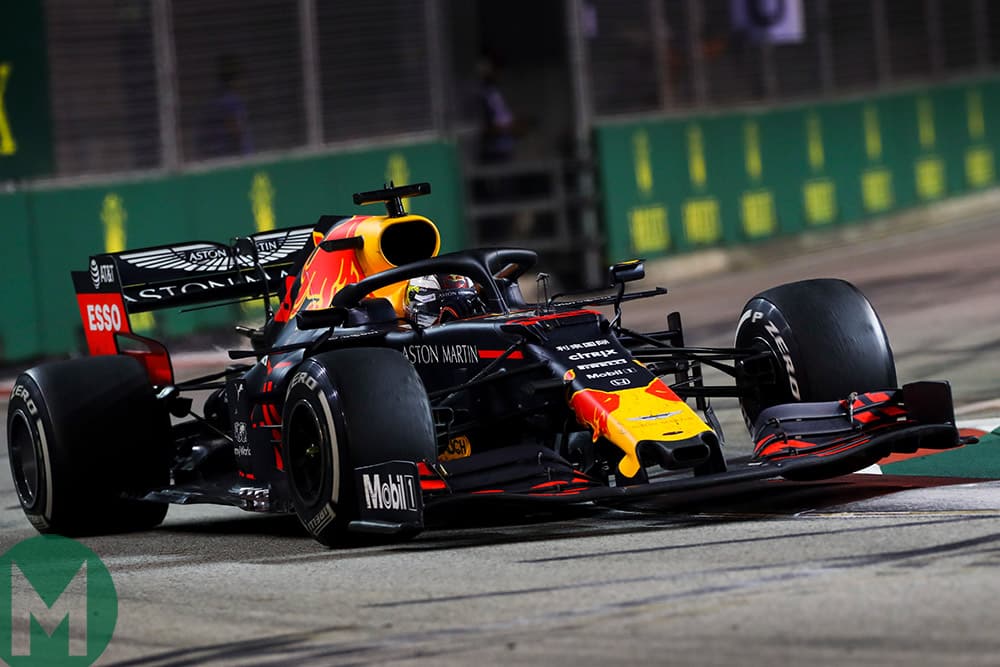
Red Bull unsettled over kerbs and bumps Photo: Motorsport Images
Watching from Turn Five – the third-gear acute-angle turn that leads onto the kinking straight of Raffles Boulevard – you see the bump on the apex only as the cars go over it. You could see it most of all on the Red Bull. That bump upset its front damping terribly, the car bouncing its way through the remaining third of the turn. On Friday Verstappen was even complaining he couldn’t keep his feet on the pedals as he was bounced around. The Mercedes was much more composed there, even if its rear damping was a little challenged. But the most comfortable-looking car through there by far was the Ferrari. It smothered that bump like a limo.
This behaviour of these three respective cars over this bump was repeated over the various kerbs and irregularities of the rest of the track.
That smooth ride used to be a trait of the Red Bull, particularly in the latter part of last year. But it seems there is something about the dynamics of the RB15 that requires its set-up to be quite unforgiving if it’s to have the sort of quick responses required into slow corners. Relative to the Ferrari – and even to the Mercedes – the Red Bull was simply too harsh-riding a car to be truly competitive around such a bumpy track. Running with less than full downforce, it was less able to smother those unexpectedly big bumps.
To a lesser extent, that nervy, lively trait seemed true also of the Mercedes here. The W10 has always been a very physical-looking car, especially into slow, bumpy corners; devastatingly fast but keeping its drivers busy, just like at Melbourne. It changes direction effectively, but on bumpy tracks that often means the drivers are still wrestling with its lively reactions on corner exits. It was consistently losing out to Ferrari on the power-limited exits because of this, even though it was quicker into them. Against the watch through the slow turns, the two traits effectively cancelled each other out: Mercedes faster in, Ferrari faster out.
That has not been the case anywhere else this year. There was something about the combination of Singapore’s bumps and Pirelli’s tyre choice that particularly suited the dynamics of the Ferrari, especially in this aero-uprated form.
So, with that as the technical backdrop determining what each of the leading contenders had beneath them, it played out as a gunslinger’s duel between Leclerc and Hamilton – with Vettel dropping from the contest in the final runs, over-striving after having set the pace on the first Q3 run by a significant margin. The onboard comparison of the Leclerc and Hamilton final laps was particularly fascinating.
Turn One. The Mercedes’ front tyres are not fully up to temperature. Hamilton has more lock on and less car rotation than Leclerc. But that’s anomalous to the comparison on the rest of the lap.
Leclerc’s audacious confidence is apparent in how close he is skimming the wall
As early as Turn Three, with the tyres now in their correct temperature range, Hamilton needs less lock to get the Merc turned in as its more lively nature becomes apparent. Hamilton is quicker into the turn, but Leclerc can then take a LOT more inner kerb, the Ferrari much more tolerant of this. So he can effectively shorten the track compared to Hamilton.
As he takes the exit kerb, power hard on, Leclerc power-slides spectacularly, the right-rear millimetres from the wall. This loses him half-a-tenth or so – but he’s made all of that and more back up by the time he exits Turn Five, the right-hander leading into the kinking straight, simply because of how much better the Ferrari is over that bump, how much earlier and harder Leclerc can get on the gas. It gives him the confidence to shave right up to the exit wall, closer to it than Hamilton.
Down the following straight the Ferrari’s extra horses kick in. But here – on a track where everyone is running their maximum wing and where therefore there’s less of a drag difference between the two cars than at Monza and Spa – the GP trace gives a pretty good indication of just how much. Tallying with what we wrote last week, the 0.16sec Leclerc makes up over Hamilton down Raffles Boulevard suggests a power advantage of around 15bhp. If that advantage had been anywhere near the 55bhp claimed by rivals, the Ferrari would have made up 0.65sec down this particular stretch of straight.
Into Turn Seven, with Leclerc now almost a quarter-second up on Hamilton, the Ferrari driver turns in earlier, Hamilton needing less lock to get the car turned on account of that more positive response. But again, Leclerc is then able to take much more inner kerb. They are as quick as each other through that turn, but it’s achieved in quite different ways.
Different techniques, but closely matched in Turn Seven Photo: Motorsport Images
Down a short chute of Nicoll Highway to the right-angle right-hander of Turn Eight, Leclerc’s audacious confidence is apparent in how close he is skimming the wall on the approach to widen his entry angle, Hamilton giving the wall a couple of inches more respect. Leclerc is earlier and harder on the gas – that greater stability again – and pulls out another 0.1sec on the Merc.
Turn Nine links Stamford Road to St Andrews Road. Again more inner kerb for Leclerc – and now he’s 0.3sec ahead on the lap. Down St Andrews Road, the Ferrari’s power advantage buys it a further 0.1sec. Turn 10 is a fourth gear kink and they are much the same as each other through it.
Into the Anderson Bridge, through Turn 11, Leclerc has a huge snap of oversteer. “I was certain I was going to lose the car. You don’t really know how you recover the car in such moments, it’s just instinct.” His confidence in keeping the momentum is quite something, like he’s flying by the seat of the pants. The incident loses him 0.1sec of his advantage over Hamilton, the damage of the moment limited by how short the bridge ‘straight’ is. In correcting the moment, he had also unknowingly altered his brake balance one notch in the ‘wrong’ direction – which he didn’t discover until watching the cockpit footage.
Through the tight Turn 13 onto the longish drag of Esplanade Drive, Leclerc is perhaps understandably a little conservative. Hamilton is in full attack mode now and launches into that turn particularly hard, very busy with the steering on exit. His exit speed advantage actually carries him down Esplanade faster than the Ferrari despite the lower power.
As they arrive at the end of it, Hamilton has clawed back to within 0.2sec of the Ferrari, with the tight twists of sector 3 – his car’s best sector – coming up. It’s as if he’s deliberately saved absolute full attack to this part of the lap in contrast to Leclerc who is giving it everything everywhere. Hamilton’s left rear wheel rim scrapes some paint and cement from the exit wall. They are both almost touching the wall on the approach to Turn 16, widening the entry with millimetre precision.
There’s nothing in it through this sector, Hamilton busier into the turns but just as fast. Through Turn 21, the flick onto the last little blast before the final corner, Hamilton dares take as much kerb as Leclerc – and is super-busy with rapid corrections as a consequence.
0.19sec split Hamilton and Leclerc in qualifying Photo: Motorsport Images
Through the first part of the double apex final turn, Hamilton prefers to downchange to fifth to get the torque to pull him through the tyre scrub. Leclerc prefers to keep the momentum of sixth. They cross the line and Leclerc is on pole by 0.19sec, which equates very closely with the Ferrari’s power advantage up Raffles Boulevard. Without Leclerc’s Turn 11 moment, he’d have been on pole even more decisively. It was a thrilling contest between two super-talents in two evenly-matched – but quite different – cars.
Mercedes had not hit it right with the set-up. The car was taking way too long to bring its front tyres up to temperature. They needed an out-lap typically 30sec faster than Ferrari – meaning they’d inevitably catch traffic on the out-laps. Ferrari by contrast had hit it perfectly. For qualifying at least. Leclerc had stressed pre-weekend that he wanted a car above all else that had a front end as that was the only conceivable way they might contend for pole and driving from pole was the only conceivable way they might win. It would have consequences – ie it would likely over-work its rear tyres in the race.
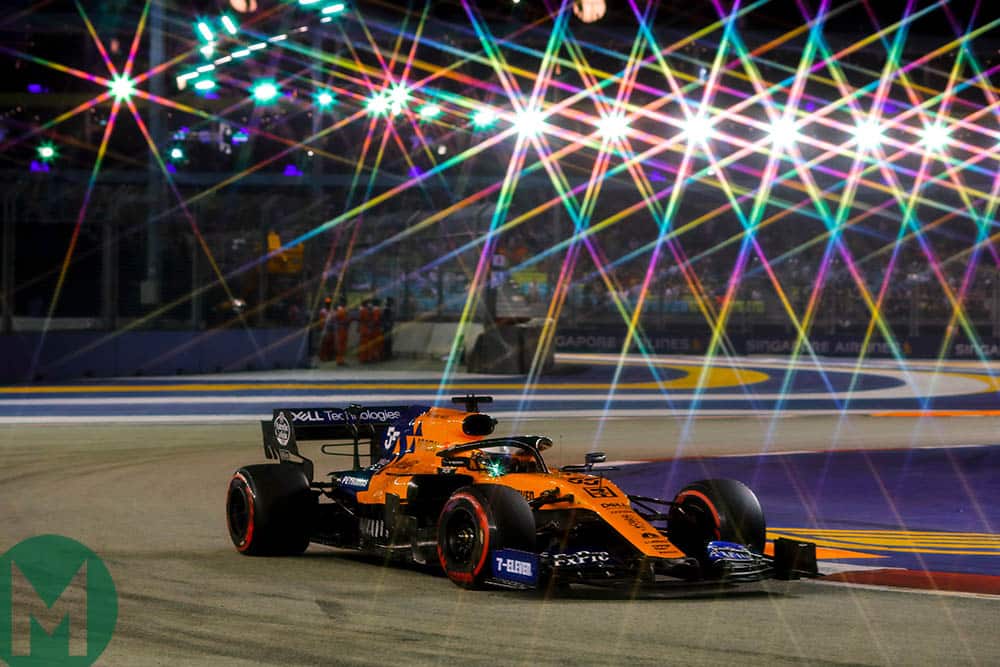
Sainz was best of the rest in qualifying after Norris error Photo: Motorsport Images
Vettel was visibly crestfallen. His first Q3 lap was superb and put him 0.3sec clear of the field. He may have reckoned that even if he got his final one wrong, it might stand as pole. In the end, it was over 0.2sec shy of what was needed and he was only third, abandoning the final attempt after a couple of wild moments.
Verstappen, fourth fastest, did well to get the Red Bull within 0.6sec of pole. Its behaviour over the bumps and kerbs meant it was simply not a front-running car around Singapore, much to his and everyone else’s surprise. He was 0.3sec faster than the Mercedes of Valtteri Bottas who was his usual 0.6-0.7sec adrift of Hamilton around these streets. Red Bull’s Alex Albon was a similar amount shy of Verstappen, but this was his first visit to the place in a car that was far from the easiest of drives. It lined him up sixth.
Best of the rest was Carlos Sainz’s McLaren but would have been team-mate Lando Norris had the latter been able to repeat his superb Q2 lap (this his first visit to the track) rather than messing up his sole Q3 lap and going only 10th.
Norris generally had a handy half-a-second over the works Renaults, which qualified eighth and ninth, Daniel Ricciardo a quarter-second faster than Nico Hülkenberg. The former was subsequently disqualified from qualifying after the Renault’s MGU-K was found to have breached the 120kW deployment limit.
The strategic implications of the tyre behaviour here meant no-one in the midfield much wanted to qualify for Q3, so as to have a better tyre choice for the race. Hülkenberg was particularly disappointed to have made it through! Sergio Perez put the further modified Racing Point 11th ahead of Antonio Giovinazzi’s Alfa, Pierre Gasly’s Toro Rosso, Kimi Räikkönen’s Alfa (which had hit the wall hard with its left-rear) and Kevin Magnussen’s Haas.
Failing to make it out of Q1 were Daniil Kvyat’s Toro Rosso, Lance Stroll’s Racing Point, Romain Grosjean’s Haas and the Williams of George Russell and Robert Kubica.
Related content
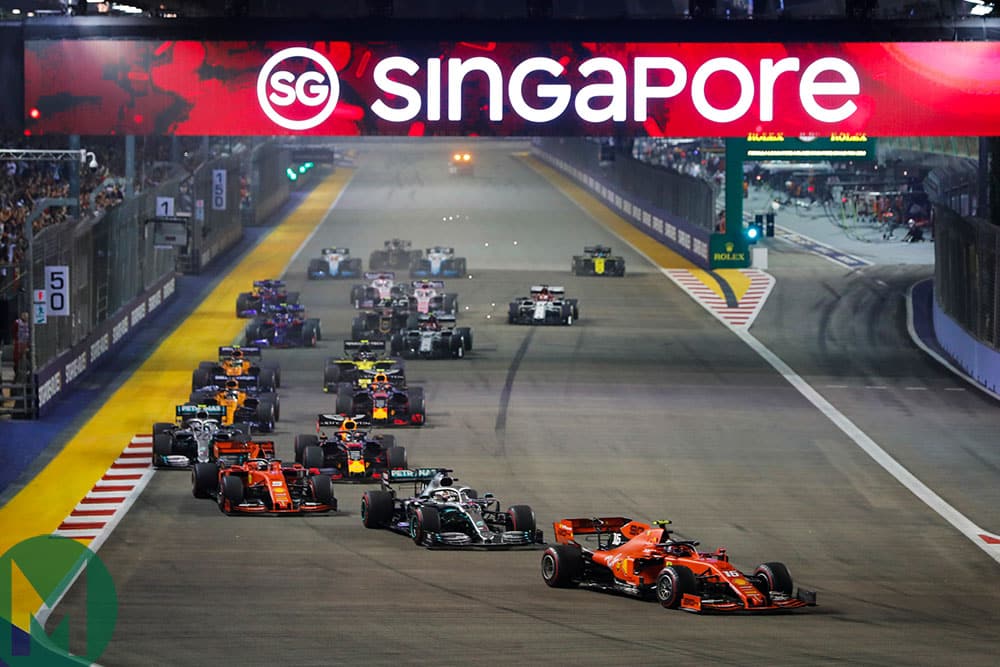
Photo: Motorsport Images
Eight-ten pm, floodlights shining bright, huge crowd under a jet-black sky, the humid atmosphere with an extra ingredient this year: a smoky haze from grassland and forest burning in neighbouring Indonesia. It drifts in without having to clear customs and was taking the air quality to ‘dangerous’ levels.
But the sightline to the gantry lights was clear enough as they went out. Leclerc comfortably converted his pole and Hamilton had to get defensive from Vettel. Verstappen, Bottas and Albon filed through but at the head of the midfield there was trouble as Hülkenberg tried to go through Turn Five side-by-side with Sainz and they didn’t fit, McLaren right-rear snagging Renault left-front and both puncturing. Their limping journey to the pitlane took them out of contention for the time being, but later safety cars would allow them modest recoveries.
This put Norris at the head of ‘Class B’ from Giovinazzi, Magnussen, Gasly (the only one outside the top 10 starting on hards rather than mediums), Räikkönen, Kvyat, Stroll, Perez, Ricciardo from his back-of-the-grid start, Grosjean, Kubica and Russell, the latter another first lap pit lane visitor with a puncture picked up from being squeezed between Kubica and Ricciardo at Turn Two.
Vettel used the Ferrari’s straightline speed to put Hamilton under some pressure into turns seven and eight, but Hamilton covered the right parts of track. This dice allowed Leclerc to extend his gap to 1sec by the end of the lap. But that was the end of any actual racing for quite some time. For the next few laps the game was one of circulation, with Ferrari instructing Leclerc to hold a pace around 12sec off his qualifying pace, only around 8sec of which would be accounted for by fuel load, engine settings etc.
Lewis Hamilton for second place on the first lap of the 2019 F1 Singapore Grand Prix” src=”https://www.motorsportmagazine.com/wp-content/uploads/2019/09/vettel_attacks_hamlilton.jpg” style=”width: 100%;” width=”1000″ height=”667″>
Vettel attacks on the first lap Photo: Motorsport Images
The recovering Williams of Russell, running unencumbered at the back, was the fastest car on track at this point, rather underlining how extreme the controlled pace was. In this way, with everyone from front to back able to lap at much the same pace, there’d be no gaps for anyone at the front to drop into as the pit stop window approached.
Ferrari, with its set up skewed towards qualifying, had shown very high rear tyre deg in the long runs of Friday. It especially needed to run the first stint as slow as possible. Hence the game plan, very similar to that run last year by Mercedes and Hamilton.
Rather like in Austria, Leclerc was straining at the leash, certain he could run much harder without killing the tyres. But the leash was held tight. Hamilton sat himself out of tyre damage range just behind, Vettel did the same as did Verstappen, Bottas, Albon etc, all the way down the field. Ricciardo, as ever, took exception to such a rule and got on with making progress through the lower end of the field, his move of choice super-late on the brakes down the inside of Turn Seven.
How was this game of cat and mouse going to play out? It couldn’t be called. The complication for those in the top 10, all of whom were obliged to start on the delicate soft, was that the midfield had all started on the harder tyres and could run much longer. So they weren’t about to start pitting and creating gaps to drop into any time soon.
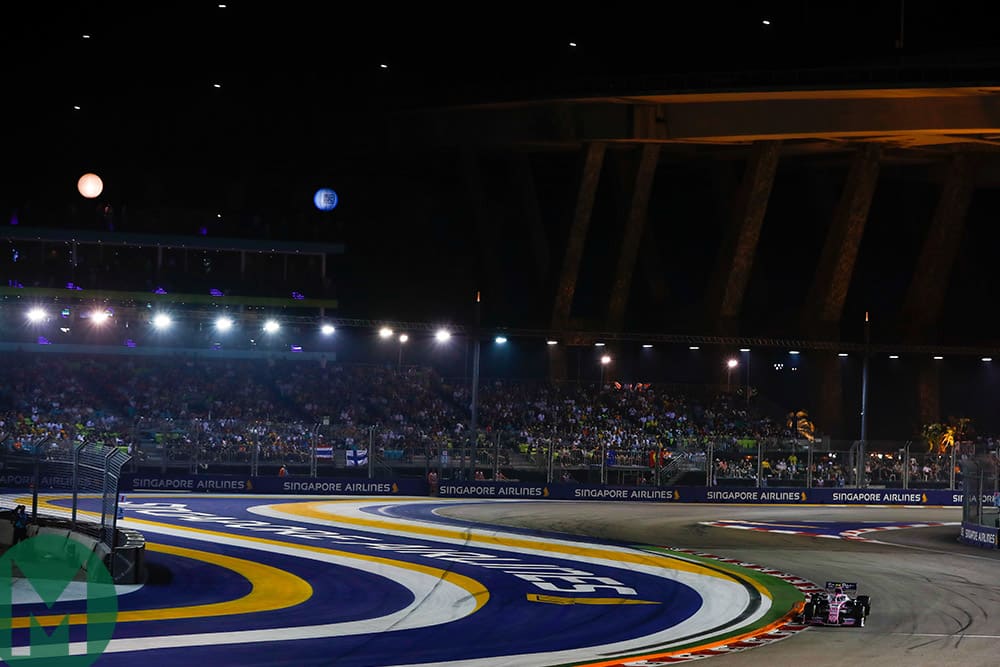
Gap behind Stroll unlocked undercut strategy Photo: Motorsport Images
Toro Rosso attempted to undercut Kvyat ahead of Perez on the 12th lap. Racing Point responded a lap later and Sergio stayed ahead. It seemed insignificant but wasn’t. It finally opened up a window – a 10sec gap between Stroll and the recovering Hülkenberg – for the front runners to drop into. The gap was available to both Ferraris and Hamilton, and would be soon to Verstappen. It was tempting but it was early. Strategists on the Ferrari and Mercedes pitwall agonised over the decision. They weren’t confident that the hard tyre could run a stint of 40-odd laps. It later turned out they under-estimated the hard and over-estimated the soft.
Which of Mercedes and Ferrari was going to attempt to plug that tempting 10sec hole back in the pack? This call was almost certainly going to determine the race’s outcome.
Mercedes resisted the temptation, just kept Hamilton out there still running right behind Leclerc. Ferrari was equally unsure – but unlike Mercedes it had a choice of two cars able to drop into the gap and so split its strategy. With no obvious right answer, it decided the riskier option was to plug that gap – and so used its second car (Vettel) to do so in the full knowledge that he might run out of tyres before the end.
Furthermore, with Verstappen due to get within reach of that gap, he could potentially undercut Vettel’s third place. It made sense to anticipate that. Besides, there was surely plenty of life left in Leclerc’s old softs, so gentle had been the pace. So he should easily be able to pit later and still hold position. Leclerc was told to push, Vettel to pit. At the same time, Red Bull told Verstappen to come in. Leclerc – and the Mercedes pair – stayed out.
But what do you know – as Leclerc and Hamilton tried to push, the tyres had nothing left to give them. From the mid 1min 48sec cruising pace, they found only about 1sec. In fact, Hamilton was just radioing in that his tyres were finished at the precise moment that Vettel peeled off from behind him into the pitlane. Ferrari had left it too late to let Leclerc off that leash. By the time they did, he had nothing. He was told to pit on the following lap. Mercedes decided to leave their guys out.
“I was asking to do the undercut,” confirmed Hamilton. “We talked about it in the meeting this morning but it was risky because you can come out in traffic and it might not work, but I was like ‘just at least take the risk’. But ultimately I didn’t know what the team knew in terms of where everyone was positioned and they took the decision to… We just missed it by one lap, basically.
“They said, ‘box this lap’, then they said, ‘do the opposite to Leclerc’ – and Vettel had already stopped. Of course, hindsight’s always a great thing so we would have stopped the same lap as Vettel.” That would likely have won Hamilton the race. Instead, he was kept out even longer in response, losing him a further place (to Verstappen), in the vain hope of a safety car to rescue things.
Fresh hards were fitted to both Vettel and Verstappen. “I knew that my race was only going to come alive around the pitstops,” related Vettel. “It was a very late call. I thought it was a bit early because I wasn’t sure I could make the tyres last the second stint. I just gave it everything on the out-lap when I saw the two cars in front of me not pitting.”
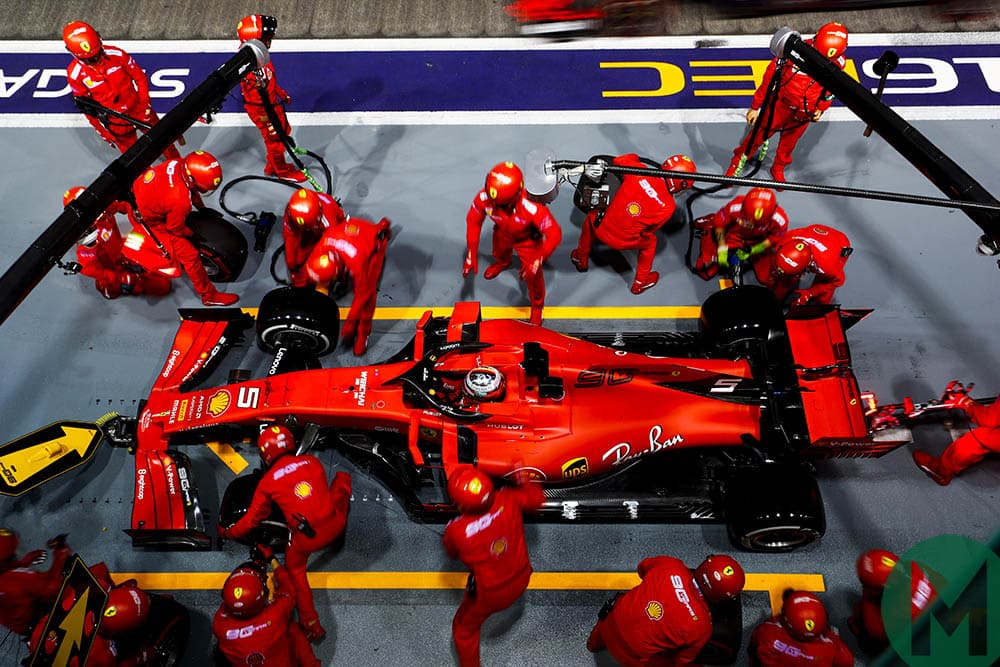
Pitstop brought Vettel’s race alive Photo: Motorsport Images
The grip of the fresh hards was vastly greater than the tired old softs – to the tune of 3.9sec! (it’s usually around 1-1.5sec). So as Leclerc (and Albon) came in next lap, Vettel was eating up his former deficit to spectacular effect. Verstappen had lost 1.5sec to Vettel on the in-lap but was similarly fast on the out-lap. Leclerc, having obeyed orders to stay on the leash when he was adamant he could have pulled away to create the necessary gap, was now in real danger of losing two places!
As he exited the pits, he was shocked to see the sister car of Vettel pass by. He hadn’t even known Vettel was pitting! At least he was able to join just in front of the Red Bull. “What the hell?” he radioed.
Bottas was brought in on the 22nd lap to fend off Albon’s undercut, rejoining just ahead. It was a frustrating experience for the Thai rookie. “I spent the whole race staring at a silver rear wing which wasn’t that fun. I couldn’t pass and so when Bottas pushed I pushed and when he saved his tyres I saved mine, so I felt like I was just going backwards and forwards and it almost felt like he backed me up so Lewis could get ahead.”
Indeed that is exactly what Bottas did do – under instruction from his team. Hamilton had stayed out until lap 26, desperately hoping there’d be a safety car (which could have sprung him into the lead). Vettel, Leclerc and Verstappen were about to catch the yet-to-pit medium-tyred Giovinazzi/Gasly/Ricciardo/Stroll group and if they were unable to pass them, it could potentially get Hamilton back the time he’d already lost to them by staying out on his old tyres. But even that wasn’t feasible, so dire was his lack of grip now becoming. Besides, Vettel scythed past the slower cars with a real purpose.
So much pace had Hamilton lost, he was set to be jumped not only by his team-mate, but also by Albon and maybe even Hülkenberg. Hence the apologetic message to Bottas from chief strategist James Vowles to back off by 3sec – to ensure Hamilton came out fourth rather than sixth or seventh. Bottas wasn’t happy about it but complied and Hamilton rejoined 5sec behind Verstappen, but on tyres seven laps newer.
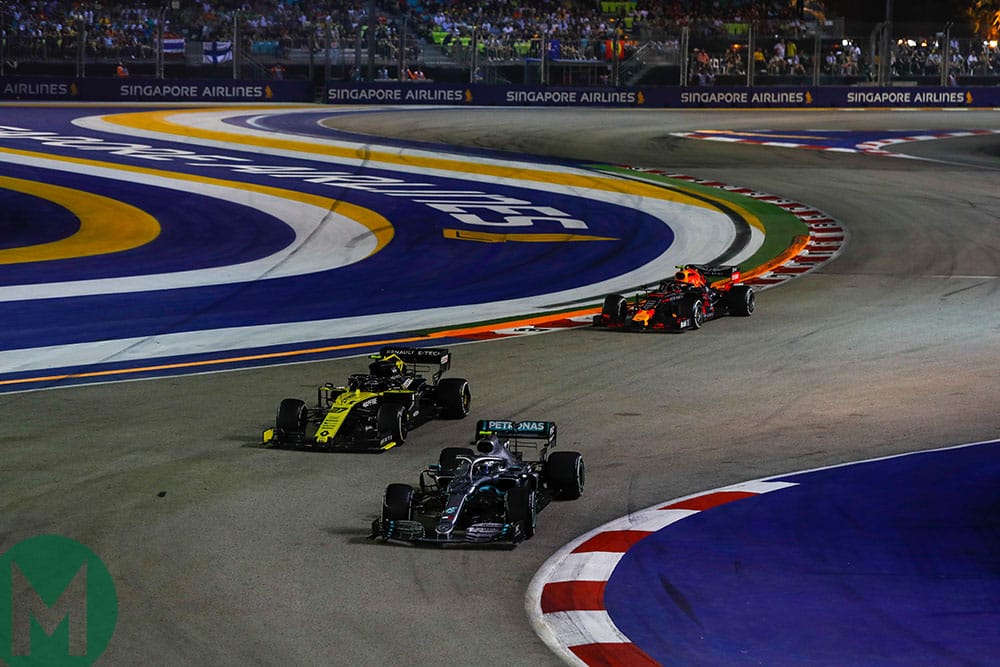
Bottas blocks for Hamilton Photo: Motorsport Images
And that’s how the roll of the dice played out. To the benefit of Vettel and the disadvantage of Leclerc and Hamilton.
All everyone had to do now was get their hard tyres to last the remaining distance. So it would be incident-free, right? Actually no. There’d be three safety cars in the remaining laps.
Meantime the yet-to-pit Giovinazzi had given Alfa Romeo the lead of a Grand Prix for the first time since Andrea de Cesaris did the same at Spa 1983. He was being pushed hard by Gasly, who was enjoying a spirited run in the Toro Rosso and fending off Ricciardo. Vettel went past them like a dose of salts, actually banging wheels with Gasly up at Turn Seven. Leclerc was more circumspect – and this was allowing Vettel to pull out a very handy lead over his frustrated team-mate, who continued to question the team about why they’d undercut him out of the lead. By the time he’d found his way by Giovinazzi into second, Vettel was 6sec up the road and apparently on his way to victory. There were discussions at Ferrari about whether to invert the positions – but they decided against it.
Gasly undercut himself ahead of Giovinazzi on the 32nd lap, the Toro Rosso now on mediums as everyone else had switched to hards, giving him the chance of a late surge. But staying out long had cost them (and Ricciardo) a lot of positions. The real picture saw Norris still heading ‘Class B’, not so far behind Bottas and Albon. Norris, Magnussen, Räikkönen, Perez, Kvyat and Stroll were lined up just ahead of Gasly, with Stroll soon to fall from contention after hitting the wall and puncturing.
But that was after Grosjean caused the first safety car by trying to hang onto the outside of Russell’s Williams well beyond the point where it was obvious he’d be pincered into the Turn Eight wall. George was out on the spot and aimed a few well-chosen words on the radio about his opinion of the Haas driver, who continued on. This wiped out Vettel’s handy cushion over Leclerc, but the five laps at safety car speeds was only helping ease Ferrari’s concerns about the durability of its rear tyres.
They’d barely got going again when Perez was told by the team to stop the car out on track to save the engine from imminent failure. Pulling off on the straight between turns 13-14, it gave the race another safety car for four laps. Vettel again sprinted away despite Leclerc asking for – and being refused – extra engine modes with which to attack on the restart.

Vettel maintained his lead over three safety car restarts Photo: Motorsport Images
Magnussen had been doing a great job keeping the Haas in the points but on worn tyres behind the safety car, his right-front eventually died and couldn’t be coaxed back into life. He was a sitting duck as the race restarted and he’d eventually make a late pit stop for a set of softs on which he set the race’s fastest lap for the second year in succession on his way to 13th. Ricciardo tried to make up a place in the mad dash of the restart and ended up losing three. Then two laps later a Turn One collision between Räikkönen and a challenging Kvyat left the Alfa stationary and brought out a third safety car.
Vettel took the precaution of making the restart break at a totally different point of the track to his previous two – just in case Leclerc had any ideas, which he almost certainly did have. The safety cars had put Hamilton on the back of Verstappen, but Max was able to defend at all the right places. “The sequence of five quite fast corners means you can never get close,” said Hamilton. “Maybe we need to change the last corner so there’s a tight hairpin to go around or something, because the last corner you can’t follow.”
The last few laps passed by. Ricciardo clashed with Giovinazzi, damaging the Alfa’s suspension. Gasly on his faster tyres was pushing Norris for seventh but could find no way by. The safety cars had helped Hülkenberg rescue his day and he was able to take ninth from Giovinazzi.
Difficult to say if this day was more significant for Vettel’s victory or Ferrari’s. But either way, it was a remarkable outcome.
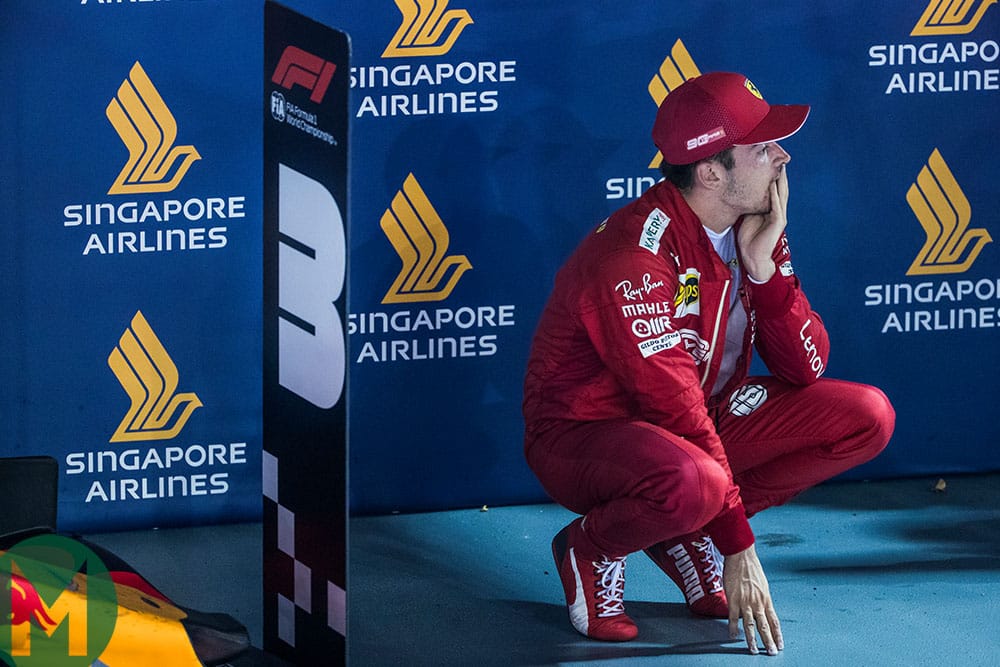
Photo: Motorsport Images
| Position | Driver | Team | Time | Points |
|---|---|---|---|---|
| 1 | Sebastian Vettel | Ferrari | 1hr 58min 33.667sec | 25 |
| 2 | Charles Leclerc | Ferrari | +02.641sec | 18 |
| 3 | Max Verstappen | Red Bull | +3.821sec | 15 |
| 4 | Lewis Hamilton | Mercedes | +4.608sec | 12 |
| 5 | Valtteri Bottas | Mercedes | +6.119sec | 10 |
| 6 | Alex Albon | Red Bull | +11.663sec | 8 |
| 7 | Lando Norris | McLaren | +14.769sec | 6 |
| 8 | Pierre Gasly | Toro Rosso | +15.547sec | 4 |
| 9 | Nico Hülkenberg | Renault | +16.718sec | 2 |
| 10 | Antonio Giovinazzi | Alfa Romeo | +27.855sec* | 1 |
| 11 | Romain Grosjean | Haas | +35.436sec | |
| 12 | Carlos Sainz | McLaren | +35.974sec | |
| 13 | Lance Stroll | Racing Point | +36.419sec | |
| 14 | Daniel Ricciardo | Renault | +37.660sec | |
| 15 | Daniil Kvyat | Toro Rosso | +38.178sec | |
| 16 | Robert Kubica | Williams | +47.024sec | |
| 17 | Kevin Magnussen | Haas | +1min 26.522sec | |
| DNF | Kimi Räikkönen | Alfa Romeo | ||
| DNF | Sergio Perez | Racing Point | ||
| DNF | George Russell | Williams |
*Includes 10sec time penalty for failing to follow the instructions of the race director
| Position | Driver | Team | Points |
|---|---|---|---|
| 1 | Lewis Hamilton | Mercedes | 296 |
| 2 | Valtteri Bottas | Mercedes | 231 |
| 3 | Charles Leclerc | Ferrari | 200 |
| 4 | Max Verstappen | Red Bull | 200 |
| 5 | Sebastian Vettel | Ferrari | 194 |
| 6 | Pierre Gasly | Toro Rosso | 69 |
| 7 | Carlos Sainz | McLaren | 58 |
| 8 | Alexander Albon | Red Bull | 42 |
| 9 | Daniel Ricciardo | Renault | 34 |
| 10 | Daniil Kvyat | Toro Rosso | 33 |
| 11 | Nico Hülkenberg | Renault | 33 |
| 12 | Lando Norris | McLaren | 31 |
| 13 | Kimi Räikkönen | Alfa Romeo | 31 |
| 14 | Sergio Perez | Racing Point | 27 |
| 15 | Lance Stroll | Racing Point | 19 |
| 16 | Kevin Magnussen | Haas | 18 |
| 17 | Romain Grosjean | Haas | 8 |
| 18 | Antonio Giovinazzi | Alfa Romeo | 4 |
| 19 | Robert Kubica | Williams | 1 |
| 20 | George Russell | Williams | 0 |
| Position | Team | Points |
|---|---|---|
| 1 | Mercedes | 527 |
| 2 | Ferrari | 394 |
| 3 | Red Bull | 289 |
| 4 | McLaren | 89 |
| 5 | Renault | 67 |
| 6 | Toro Rosso | 55 |
| 7 | Racing Point | 46 |
| 8 | Alfa Romeo | 35 |
| 9 | Haas | 26 |
| 10 | Williams | 1 |

Alain Prost has given his view on Renault exiting F1 as an engine manufacturer

Mark Hughes weighs up an exceptional 2025 rookie class, dissecting four contrasting debut seasons to reveal who truly stood out the most

Mohammed Ben Sulayem's has now been re-elected as FIA president, after a controversial first term. But how did he become the first non-European president in the FIA's history?

Cadillac is in a race against time to get its new F1 car ready for 2026 – sim driver Pietro Fittipaldi explains how it's running in the virtual world first